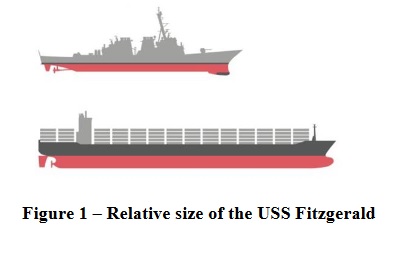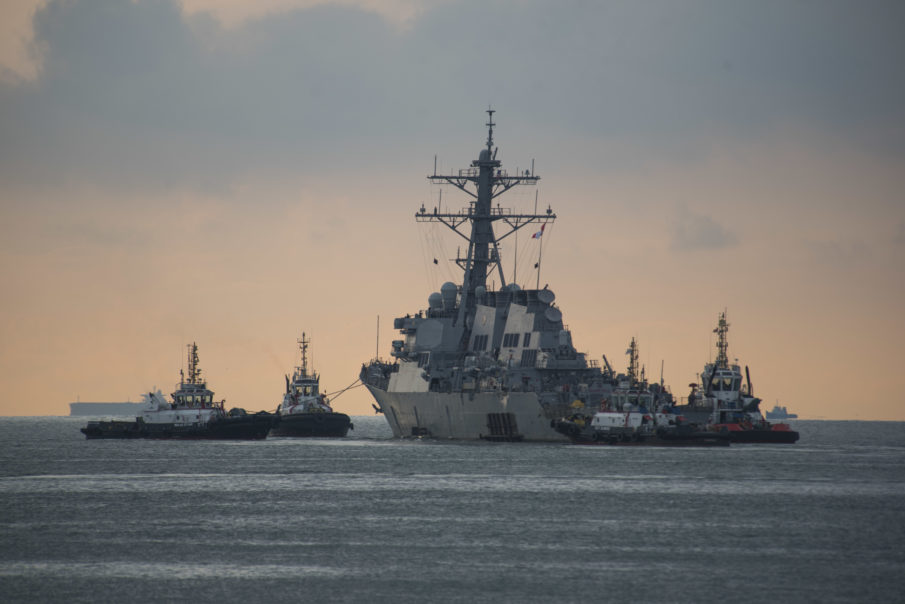On Wednesday, the U.S. Navy released reports detailing the events that led to two tragic collisions between U.S. Navy ships and commercial vessels that occurred earlier this year. These separate incidents, one involving the USS Fitzgerald (DDG 62) and another involving the USS John S. McCain (DDG 56), both shared a single culprit, according to the Navy investigations: the failure of the command on board.
“Both of these accidents were preventable and the respective investigations found multiple failures by watch standers that contributed to the incidents,” said Chief of Naval Operations (CNO) Adm. John Richardson. “We must do better.”
On June 17, the Arleigh Burke class guided missile destroyer USS Fitzgerald collided with the merchant ship ACX Crystal in calm waters and good weather, some 90 miles Southwest of Tokyo. Two months later, on August 21, another destroyer, the USS John S. McCain, named for the father and grandfather of Senator John McCain, struck the Alnic MC off the coast of Singapore. The two incidents resulted in the deaths of 17 sailors as well as dozens of injuries. In the aftermath, the command elements aboard both vessels, as well as their senior leadership at 7th Fleet, have been relieved. Adm. Richardson commented:
Our culture, from the most junior sailor to the most senior Commander, must value achieving and maintaining high operational and warfighting standards of performance and these standards must be embedded in our equipment, individuals, teams and fleets. We will spend every effort needed to correct these problems and be stronger than before.”
Now, the Navy has concluded that the sailors running bridge operations at the times of the collisions were to blame.

The USS Fitzgerald
In the case of the USS Fitzgerald, the Navy listed the following five failures as responsible for the collision with the ACX Crystal:
- Failure to plan for safety.
- Failure to adhere to sound navigation practice.
- Failure to execute basic watch standing practices.
- Failure to properly use available navigation tools.
- Failure to respond deliberately and effectively when in extremis.
According to the investigation, the USS Fitzgerald found itself crossing paths with three merchant vessels in the moments leading up to the collision.

Already have an account? Sign In
Two ways to continue to read this article.
Subscribe
$1.99
every 4 weeks
- Unlimited access to all articles
- Support independent journalism
- Ad-free reading experience
Subscribe Now
Recurring Monthly. Cancel Anytime.
In accordance with the International Rules of the Nautical Road, the FITZGERALD was in what is known as a crossing situation with each of the vessels. In this situation, FITZGERALD was obligated to take maneuvering action to remain clear of the other three, and if possible, avoid crossing ahead. In the event FITZGERALD did not exercise this obligation, the other vessels were obligated to take early and appropriate action through their own independent maneuvering action. In the 30 minutes leading up to the collision, neither FITZGERALD nor CRYSTAL took such action to reduce the risk of collision until approximately one minute prior to the collision. FITZGERALD maintained a constant course of 190 degrees at 20 knots of speed.”
The Officer of the Deck apparently mistook the Crystal for another, further off vessel in the darkness, and chose to take no action as it approached until it was too late to avoid a collision.
The Officer of the Deck, the person responsible for safe navigation of the ship, exhibited poor seamanship by failing to maneuver as required, failing to sound the danger signal and failing to attempt to contact CRYSTAL on Bridge to Bridge radio. In addition, the Officer of the Deck did not call the Commanding Officer as appropriate and prescribed by Navy procedures to allow him to exercise more senior oversight and judgment of the situation.”
External damage to the USS Fitzgerald
Other officers on the bridge and in the Combat Information Center of the ship were also cited for failing to provide adequate situational awareness and input to the Officer of the Deck.
The Navy ultimately cited failures in training, in Seamanship and navigation, and in the leadership and culture of the vessel for the incident.
The USS John S. McCain
The investigation into the collision between the McCain and the Alnic MC did acknowledge that mistakes were made by the crew following a brief issue with the ship’s steering and propulsion system, but cited the bridge crew for losing situational awareness as they addressed it. The investigation also revealed that the sailors operating that steering and propulsion system lacked the training necessary to serve in that capacity.
At 0519, the Commanding Officer aboard the McCain reportedly noticed,
“…the Helmsman (the watchstander steering the ship) having difficulty maintaining course while also adjusting the throttles for speed control. In response, he ordered the watch team to divide the duties of steering and throttles, maintaining course control with the Helmsman while shifting speed control to another watchstander known as the Lee Helm station, who sat directly next to the Helmsman at the panel to control these two functions, known as the Ship’s Control Console.”
Unfortunately, the shift in controls was not executed properly, causing confusion among the bridge crew. While the Commanding Officer had ordered only the speed control to be shifted from one post to the other, steering control was shifted as well. This confusion was perceived by the bridge crew as a loss of steering all together.
In the confusion, the Commanding Officer ordered a reduction in speed to 10 knots and then to 5, but because the throttles were not properly coupled, the helmsman reduced the throttle input only on the port shaft, leaving the starboard prop running at 20 knots for another 68 seconds. Although steering was never lost, the confusion on the bridge as to how to manage it, as well as the incorrect management of the vessel’s throttle, resulted in the ship taking an uncommanded turn to port.
Although JOHN S MCCAIN was now on a course to collide with ALNIC, the Commanding Officer and others on the ship’s bridge lost situational awareness. No one on the bridge clearly understood the forces acting on the ship, nor did they understand the ALNIC’s course and speed relative to JOHN S MCCAIN during the confusion.”
External damage to the USS John S. McCain
Similar to the Fitzgerald incident, the Navy ultimately cited a number of issues aboard the McCain for the incident, including a lack of appropriate training for the bridge crew, failures to adhere to navigation procedure and a failure of the command culture aboard the ship.
Images courtesy of the U.S. Navy











